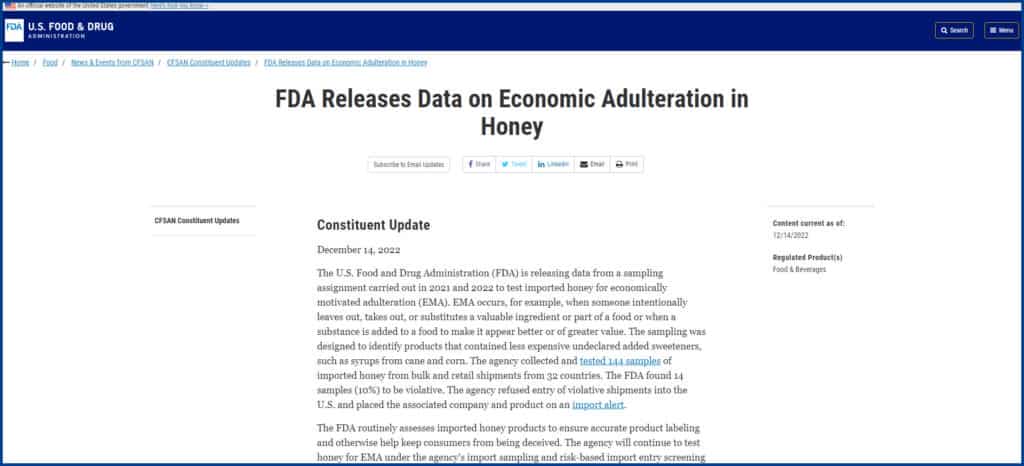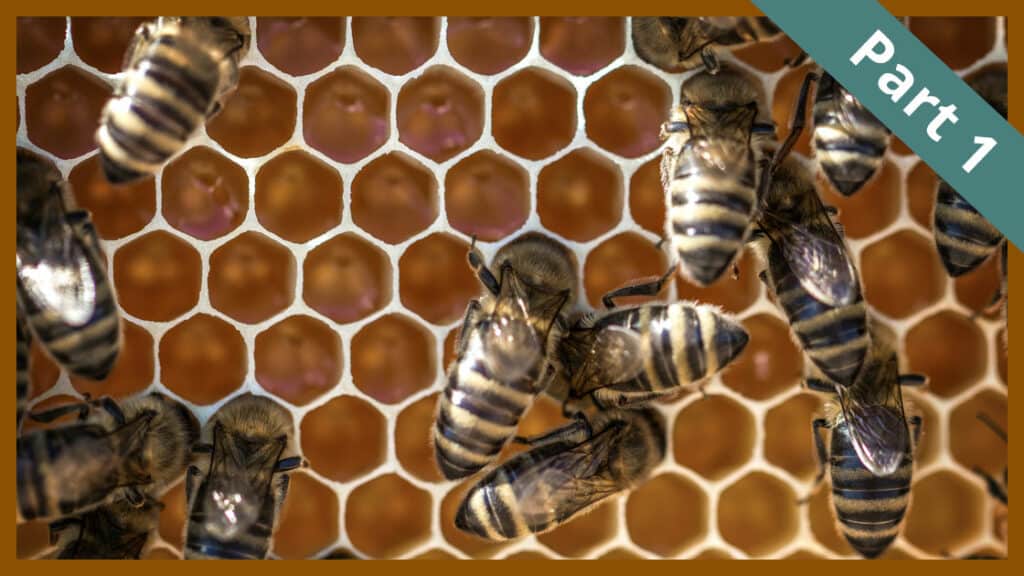Last week, this Constituent Update was published: ‘FDA Releases Data on Economic Adulteration in Honey.’ This blog post will review the report and provide actionable intelligence for your possible response. A later post of Part 2 will address how your food fraud prevention strategy should incorporate this new information.
Whenever an agency such as the US Food and Drug Administration publishes a formal report with test results, it is important to conduct a quick, detailed review that focuses on your immediate actions, as well as to identify longer-term insights. To get a full perspective on the meaning and impact of the FDA findings, a review was also conducted on each link that FDA provided and all the supplemental materials.
FDA Releases Data on Economic Adulteration in Honey (Dec 14, 2022)
The “sampling assignment” was conducted from January 2021 to March 2022, with the final report published in this “Constituent Update” on December 14, 2022.
This was NOT a response to a specific incident and is NOT a new concern about this product. This was an ongoing review of honey adulteration. “The FDA routinely assesses imported honey products to ensure accurate product labeling and otherwise help keep consumers from being deceived.”
To note: “The FDA recognizes that the term “honey” commonly refers to the thick, sweet, syrupy substance that bees make from the nectar of plants or their secretions and store in honeycombs.”
“The sampling was designed to identify products that contained less expensive undeclared added sweeteners, such as syrups from cane and corn. The agency collected and tested 144 samples of imported honey from bulk and retail shipments from 32 countries. The FDA found 14 samples (10%) to be violative.”
- KEY INSIGHT: This is an extremely important report since it is from the FDA and has test results and conclusions. After reading only the first document, there is a significant concern since the FDA found 10% of the honey samples to be a violation.
- KEY INSIGHT: More information is needed before you take any action. Even though there is a very high level of fraud documented in a public report, a specific supply chain may have a very low fraud opportunity based on supplier selection, product mix, or quality control plans including authenticity tests. While this is an extremely concerning report result, this may not be representative of the fraud opportunity in your system.

FY21/22 Sample Collection and Analysis of Imported Honey for Economically Motivated Adulteration
The Constituent Update (the first report) was a summary of the test results that were published in this second report. This second report provided no detail on the sampling plan, such as if this was a random sample of all imports from a country or if this was from a targeted group or type of source.
FDA acknowledged that, for several reasons, this data applies only to the sample collected. “The agency cautions against making inferences or comparisons based solely on the Figure 1 data [presented in the full FDA report] in view of the small sample sizes and the fact that the agency did not design the assignment for such purposes.” First, this is a very small sample size to judge the exports for an entire country (e.g., 144 samples for 32 countries is an average of only 4.5 per country). Also, the “sampling assignment” was not conducted to evaluate the country’s propensity for honey fraud.
[Note: Based on this FDA statement, the review of specific country results will be the subject of a future blog post.]
“The FDA used Stable Carbon Isotope Ratio Analysis (SCIRA) to analyze the organic composition of each honey sample to determine whether the honey was in compliance.”
- KEY INSIGHT & ACTION: Use Stable Carbon Isotope Ratio Analysis (SCIRA) to correlate your honey authentication monitoring with FDA.
The Discussion section stated that: “The results of this assignment reaffirm the need for the agency to continue to test imported honey for economically motivated adulteration [food fraud, adulterant-substances] under the agency’s risk-based import entry screening program.”
- KEY INSIGHT: Conducting honey authenticity tests will remain an agency focus for imported honey.
Guidance for Industry: Proper Labeling of Honey and Honey Products, (March 2018)
The new reports reference this earlier 2018 Honey Guidance for Industry.
“This guidance is intended to advise the regulated industry on the proper labeling of honey and honey products in accordance with sections 402 [Adulterated Foods] and 403 [Misbranded Foods] of the Federal Food, Drug, and Cosmetic Act (the FD&C Act) (21 U.S.C. 342 and 343) and its implementing regulations.”
It is crucial to note that these are just recommendations and ‘non-binding’ and ‘do not establish enforceable responsibilities.’ “FDA’s guidance documents, including this guidance, do not establish legally enforceable responsibilities.” “Instead, guidances describe [FDA] current thinking on a topic and should be viewed only as recommendations, unless specific regulatory or statutory requirements are cited.”
The guidance addresses key questions such as: “How shall I name my honey; do I have to declare the floral source of honey; if a food consists of honey and a sweetener, such as sugar or corn syrup, can I label the food as only “honey”?
- KEY INSIGHT: While the FDA guidance is non-binding and not legally enforceable, it would seem unwise to ignore guidance recommendations from an agency.
Economically Motivated Adulteration (Food Fraud)
Under the FDA Compliance & Enforcement web page there is another web page that published this review of the “Economically Motivated Adulteration (Food Fraud).” This content will be reviewed in more detail later, but we will now consider insight related to honey fraud.
[Note: When addressing the problem, the FDA report uses both economically motivated adulteration and food fraud terms. In this web page report, economically motivated adulteration was used three times, “EMA” without the full name was mentioned nine times, and food fraud was mentioned 26 times.]
Honey and maple syrup were one category of five “Examples of Food Fraud,” including olive oil, seafood, juice, and spices.
- KEY INSIGHT & ACTION: This reaffirms that honey adulteration is a key agency focus for imports but also for a product in the domestic market. But this also is a reminder of four other key products (olive oil, seafood, juice, and spices) which should remain a priority in a food fraud prevention strategy.
The report identifies the key laws and regulations that FDA applies to food fraud:
- The Federal Food, Drug, and Cosmetic Act (FD&C Act): Section 402(b) [Adulterated Foods] of this act (21 U.S.C. 342(b) [Misbranded Foods])
- FDA Food Safety Modernization Act (FSMA)
- Labeling Regulations (21 CFR 101.30, among others)
- Standard of Identity Regulation: (See 21 CFR 130 (general), 21 CFR 133 (cheese), 21 CFR 146 (juices), and 21 CFR 168 (sweeteners and syrups) for examples.)
- KEY INSIGHT & ACTION: The FDA has listed the key laws and regulations that apply to honey fraud. These should be included in a Food Fraud Prevention Strategy.
- KEY INSIGHT: This FDA report, and the blog post review, focus on FDA, but some other non-food laws and regulations must be followed to meet full US compliance requirements.
- KEY INSIGHT & ACTION: Cheese was included as an additional product that is a focus of FDA food fraud concerns. Cheese, as it applies to standard of identity in this this FDA food fraud report, should be identified as a priority in a Food Fraud Prevention Strategy.
In the “Monitoring for Food Fraud” section, it is stated that “Here are some of the ways we regularly work to monitor the food market for the EMA:”
- Detecting Food Fraud: The actions include: monitoring news reports and scientific publications, inspections, and targeted sampling assignments.
- Confirming Food Fraud Through Testing: FDA conducts tests and develops new test methods to adapt to the emerging fraud opportunity.
- Collaborating with Other Regulatory Partners: E.g., Customs, National Oceanic and Atmospheric Administration, and the Department of Justice.
- KEY INSIGHT: FDA is actively monitoring and evolving the test methods, including coordination with other US and international agencies.
Honey: Import Alert 36-01 “Adulteration of Honey”
FDA has an online and publicly available “List of firms and their products subject to Detention without Physical Examination (DWPE) under this Import Alert (a.k.a. Red List).”
- KEY INSIGHT & ACTION: It would be efficient to monitor the FDA’s publicly available list of firms (companies) that have import alerts. This could be a key data source for “New Information” under the “Public Policy” section in the Food Fraud Prevention Cycle (FFPC).
Takeaway Points
- It is always important to quickly and thoroughly review agency-published reports on food fraud, especially when there are test results.
- It is also important to thoroughly review the findings in relation to your countermeasures and supply chain controls. In some cases, there may be widespread food fraud in the industry, BUT your supply chain may have a low fraud opportunity.
- Government-published food fraud reports provide insight into the test methods, targeted products, types of fraud from specific sources, and the general level of oversight on particular problems. This insight can be used to update a food fraud vulnerability assessment risk rankings or the focused actions conducted in a food fraud prevention strategy.

